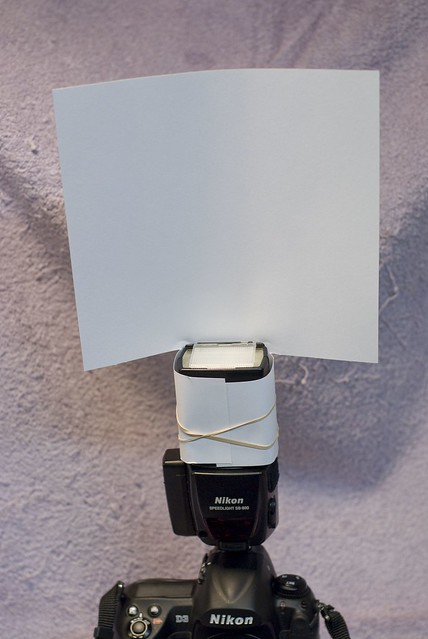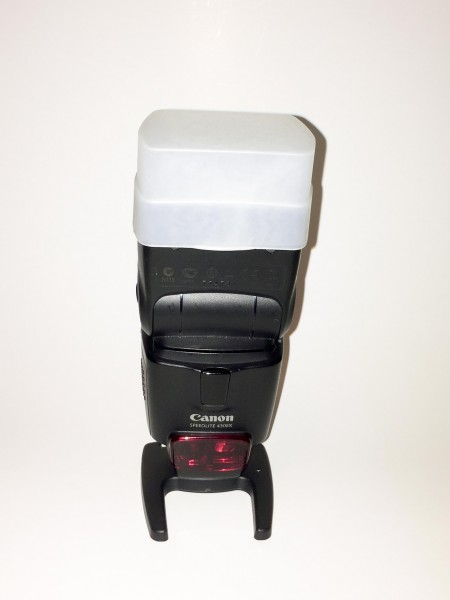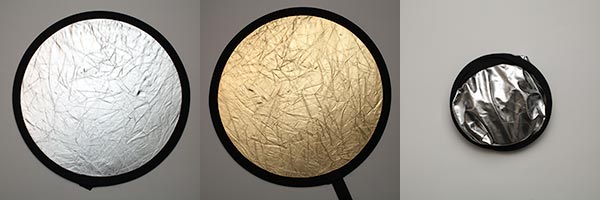For the uninitiated, flash photography can be scary. There’s all this talk about lighting ratios and sync speed and…it gets to a point where some people just check out of the conversation and carry on using their pop-up flash, despite less than stellar results. But even those who have made the courageous move to at least experiment with off camera flash often find themselves hating the way their photos look. The most common cause of this unhappiness is due to using bare flash. It won’t matter if your settings are perfect, aiming a bare flash at your subject is sure to stand between you and photographic satisfaction. The good news is bare flash syndrome is easily averted — all you need to do is modify the light.
The tools below will assist you in shaping and controlling the harsh light produced by your flash, allowing you to avoid those unflattering shadows.
Basic Flash Bounce Diffuser
This simple apparatus is deceptively effective. Sure, it’s nothing more than a translucent plastic cap but it’s an affordable, portable method of softening the flash light. Just place it on your speedlight, tilt and swivel the head to your desired position and you’ll notice a marked improvement in the quality of lighting. Given how small and light these diffusers are, you can easily keep one with you anywhere you are; in fact, you might just keep it attached to your flash full time. When purchasing a diffuser, be sure to get the one molded to fit your specific flash head. This is a gadget that shouldn’t cost you more than $12USD. But if you’re looking for a DIY solution, you can always cover your flash head with just about any translucent material you’ve got at home — parchment paper, a section of an old white bed sheet, or even a coffee filter.
Bounce Card
Another simplistic method of controlling flash lighting, some flash units have a built in bounce card that you can extend anytime you need it. It may not be as effective as more elaborate modifiers but a bounce card serves its purpose admirably, especially in a pinch. The main drawback of a bounce card, however, is its lack of versatility — it can bounce perfectly well, but that’s about it. Luckily, Rogue make a line of modifiers known as FlashBenders that attach to a flash unit with velcro and allow to you direct light however you want; it can act as a reflector to bounce light onto a subject (the white/reflective side) or act as a flag to block light from a subject (the black side). And its flexible frame can be bent into any shape you want. Unsurprisingly, Rogue’s FlashBenders are going to cost you more than a basic bounce card will; depending on which incarnation you select you will pay anywhere from $25 – $100USD. For the DIYers, you can make your own bounce cards and flags with materials as simple as poster board/foamcore, velcro, a steady hand and this tutorial.

DIY bounce card. Photo by Dwight Sipler
Reflector
A reflector, in short, allows you to direct light onto your subject. Reflectors come in a large variety of sizes and shapes; they can also be had in a few different colors — typically silver, white, gold, and black. If you are looking for soft fill light, the white reflector will be your best option. The silver reflector will obviously reflector more light than the white, while the gold will cast some warmth onto your subject. When choosing a reflector size, remember that the larger a light source is relative to the subject, the softer the light will be. A big 42-inch reflector doesn’t sound like it would be easily portable, but a collapsible reflector can fold down to about 1/3 of its full size. You can find 5-in-1 reflector sets starting at approximately $20USD. Or you can build your own silver reflector by following this tutorial; if you need a white reflector, white foamcore stands in perfectly.
Softbox
A staple amongst those who work with flash regularly, a softbox is a shoot-through diffuser typically attached to larger strobes. There are, however, smaller more portable versions that fasten to standard flash units. Still, one potential problem with such modifiers is that the bigger diffusion surface will block the flash’s AF assist sensor, in which case you will have to use manual mode. One of the most popular softboxes is made by LumiQuest; on average you will pay around $40USD for one. Alternatively, you can use items ranging from a lampshade to a t-shirt to a coat hanger to craft a softbox for yourself.
Don't let flash photography get you down; it's all about controlling the light and, as you've seen, there are plenty of gadgets available to help you achieve that end.







1 Comment
I like the Graslon products as effective diffusers for the soft box category. The Prodigy in particular does an amazing job of softening the light and eliminating shadows.